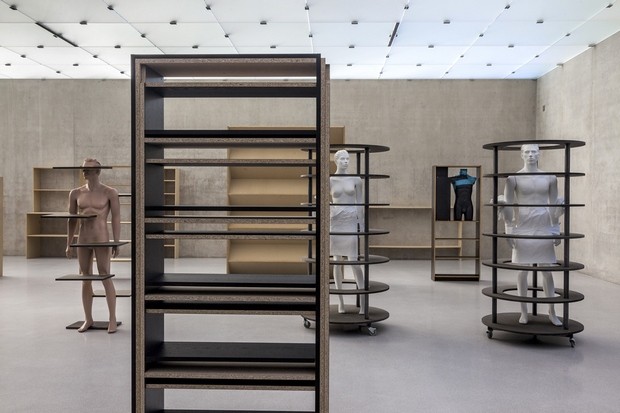Heimo Zobernig
12 Nov 2015 - 10 Jan 2016
HEIMO ZOBERNIG
12 November 2015 – 10 January 2016
Heimo Zobernig constructs platforms, fabricates sculptures, whitewashes temporary exhibition walls, paints canvases, shoots videos, and appears in performances. He is continually involved in questions of how simplicity can be extracted from complexity. He has been highly influential not only within his native art scene but also in international discourses on art and the wider world of exhibitions. Zobernig began his career with small-scale paintings and black lacquered cardboard objects. His paintings were reactions to neoexpressionism and responses to the utopian, which since modernism has been associated with the austerely formal. Likewise in his sculptures, he utilizes simple methods of disclosure to make visible the historical charge within objects, which often adopt the appearance of initial models, simple prototypes, or cheap placeholders. He also modifies the rarely visible apparatus of exhibitions such as plinths, walling, platforms, and podiums.
In his exhibition at Kunsthaus Bregenz Heimo Zobernig is showing a variety of empty shelving on the first floor. For Zobernig shelves exhibit a relationship to human scale, never merely functional but always also becoming, as he expresses it, a »counterpart.« The second floor is divided by a black curtain that enters into a symbiosis with KUB’s architecture. Visitors entering are faced with the decision of whether to experience the newly created space surrounded by fabric, or peer behind the curtain.
For the Bregenz exhibition Zobernig is continuing considerations begun at the Biennale, adapting them to Peter Zumthor’s architecture. On the third floor a portion of the KUB ceiling’s glass panels is to be removed and a black ceiling, as already seen in the Hoffmann Pavilion at the Biennale, integrated instead, adopting one to one the measurements used in Venice. The sculpture originally envisaged for Venice but not actually exhibited there, is being exhibited in Bregenz for the first time. It is the cast of a human figure assembled from various modified mannequins. The human form represents a new step away from the reductive and a return to complexity — the complexity of human perception, the human figure, and historical remembrance.
Biography
Heimo Zobernig
Heimo Zobernig, born in 1958 in Mauthen, lives in Vienna. From 1977 to 1980 he studied at the Academy of Fine Arts Vienna and from 1980 until 1983 at the University of Applied Arts Vienna. In 1994 and 1995 he was a guest professor at the University of Fine Arts of Hamburg. In 1999 and 2000 he taught sculpture at the Staatliche Hochschule für Bildende Künste – Städelschule, Frankfurt. Since 2000 he has been Professor of Sculpture at the Academy of Fine Arts Vienna.
12 November 2015 – 10 January 2016
Heimo Zobernig constructs platforms, fabricates sculptures, whitewashes temporary exhibition walls, paints canvases, shoots videos, and appears in performances. He is continually involved in questions of how simplicity can be extracted from complexity. He has been highly influential not only within his native art scene but also in international discourses on art and the wider world of exhibitions. Zobernig began his career with small-scale paintings and black lacquered cardboard objects. His paintings were reactions to neoexpressionism and responses to the utopian, which since modernism has been associated with the austerely formal. Likewise in his sculptures, he utilizes simple methods of disclosure to make visible the historical charge within objects, which often adopt the appearance of initial models, simple prototypes, or cheap placeholders. He also modifies the rarely visible apparatus of exhibitions such as plinths, walling, platforms, and podiums.
In his exhibition at Kunsthaus Bregenz Heimo Zobernig is showing a variety of empty shelving on the first floor. For Zobernig shelves exhibit a relationship to human scale, never merely functional but always also becoming, as he expresses it, a »counterpart.« The second floor is divided by a black curtain that enters into a symbiosis with KUB’s architecture. Visitors entering are faced with the decision of whether to experience the newly created space surrounded by fabric, or peer behind the curtain.
For the Bregenz exhibition Zobernig is continuing considerations begun at the Biennale, adapting them to Peter Zumthor’s architecture. On the third floor a portion of the KUB ceiling’s glass panels is to be removed and a black ceiling, as already seen in the Hoffmann Pavilion at the Biennale, integrated instead, adopting one to one the measurements used in Venice. The sculpture originally envisaged for Venice but not actually exhibited there, is being exhibited in Bregenz for the first time. It is the cast of a human figure assembled from various modified mannequins. The human form represents a new step away from the reductive and a return to complexity — the complexity of human perception, the human figure, and historical remembrance.
Biography
Heimo Zobernig
Heimo Zobernig, born in 1958 in Mauthen, lives in Vienna. From 1977 to 1980 he studied at the Academy of Fine Arts Vienna and from 1980 until 1983 at the University of Applied Arts Vienna. In 1994 and 1995 he was a guest professor at the University of Fine Arts of Hamburg. In 1999 and 2000 he taught sculpture at the Staatliche Hochschule für Bildende Künste – Städelschule, Frankfurt. Since 2000 he has been Professor of Sculpture at the Academy of Fine Arts Vienna.


